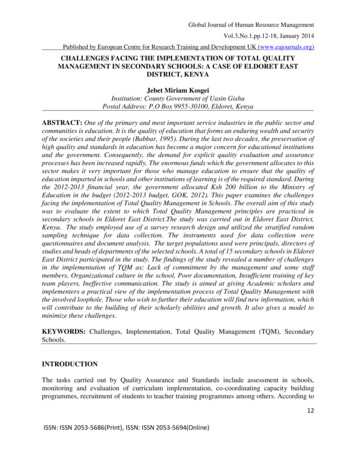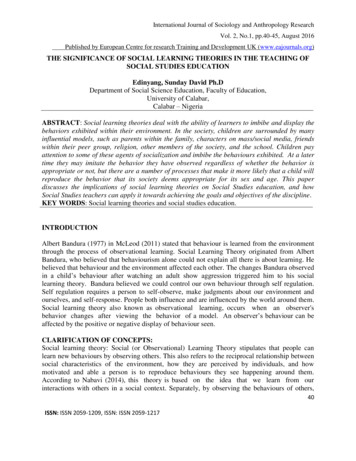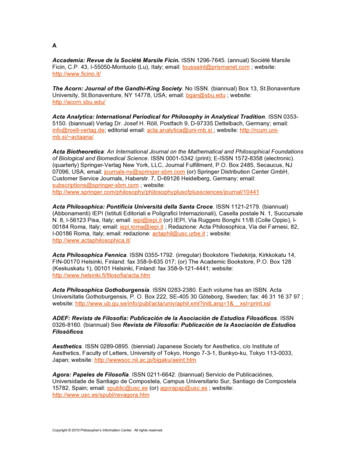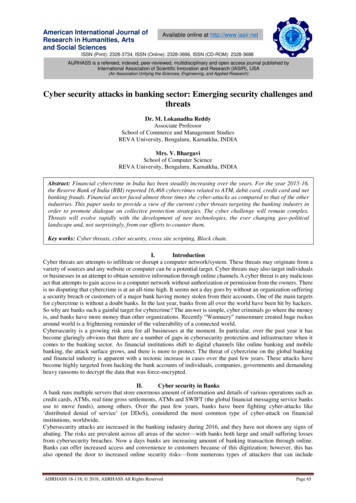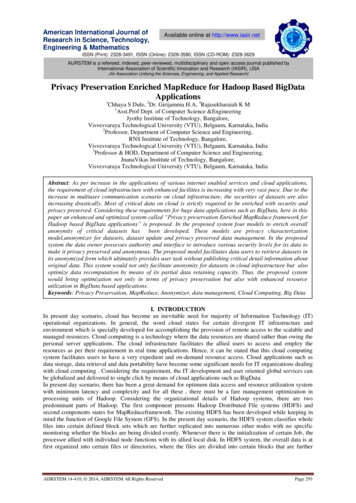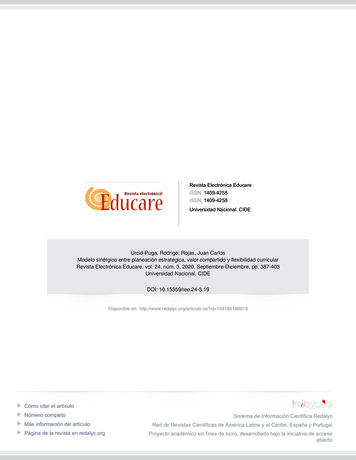
Transcription
ISSN 2220-3206 (online)World Journal ofPsychiatryWorld J Psychiatr 2020 July 19; 10(7): 150-174Published by Baishideng Publishing Group Inc
WJ PWorld Journal ofPsychiatryContentsMonthly Volume 10 Number 7 July 19, 2020ORIGINAL ARTICLEBasic Study150Comparison of three administration modes for establishing a zebrafish seizure model induced by NMethyl-D-aspartic acidLong XY, Wang S, Luo ZW, Zhang X, Xu HSYSTEMATIC REVIEWS162Pimavanserin for the treatment of psychosis in Alzheimer’s disease: A literature reviewSrinivasan S, Tampi RR, Balaram K, Kapoor AWJPhttps://www.wjgnet.comIJuly 19, 2020Volume 10Issue 7
World Journal of PsychiatryContentsMonthly Volume 10 Number 7 July 19, 2020ABOUT COVEREditorial board member of World Journal of Psychiatry, Dr. Löffler-Stastka is the Dean for Postgraduate ProgramsMedical University Vienna, Head of the University Program for Psychotherapy Research, Head of the UniversityProgram for Health Care Management, University Professor for Psychoanalysis and Psychotherapy, TrainingTherapist for Psychoanalytic Psychotherapy. She studies on process-outcome research, assessment tools,psychotherapeutic/medical care, therapist variable (attitude, countertransference, empathy, mentalization, microexpressions, therapeutic competencies) and research concerning educational and training issues. Mid careercounselor of the SPRISTAD group/Society for Psychotherapy Research. Besides, studies concerning competencedevelopment will go on in several settings, conceptual research leads to discussions about competencies that arerelevant for neighbouring disciplines and policies.AIMS AND SCOPEThe primary aim of World Journal of Psychiatry (WJP, World J Psychiatr) is to provide scholars and readers fromvarious fields of psychiatry with a platform to publish high-quality basic and clinical research articles andcommunicate their research findings online.WJP mainly publishes articles reporting research results and findings obtained in the field of psychiatry andcovering a wide range of topics including adolescent psychiatry, biological psychiatry, child psychiatry,community psychiatry, ethnopsychology, psychoanalysis, psychosomatic medicine, etc.INDEXING/ABSTRACTINGThe WJP is now abstracted and indexed in Science Citation Index Expanded (SCIE, also known as SciSearch ),Current Contents/Clinical Medicine, Journal Citation Reports/Science Edition, PubMed, and PubMed Central. The2020 edition of Journal Citation Reports cites the 2019 impact factor (IF) for WJP as 3.545; IF without journal selfcites: 3.545; Ranking: 46 among 155 journals in psychiatry; and Quartile category: Q2.RESPONSIBLE EDITORS FOR THIS ISSUEElectronic Editor: Yun-Xiaojian Wu; Production Department Director: Xiang Li; Editorial Office Director: Jia-Ping Yan.NAME OF JOURNALINSTRUCTIONS TO AUTHORSWorld Journal of SNGUIDELINES FOR ETHICS DOCUMENTSISSN 2220-3206 CH DATEGUIDELINES FOR NON-NATIVE SPEAKERS OF ENGLISHDecember 31, YPUBLICATION 8EDITORS-IN-CHIEFPUBLICATION MISCONDUCTRajesh R AL BOARD MEMBERSARTICLE PROCESSING CATION DATESTEPS FOR SUBMITTING MANUSCRIPTSJuly 19, TONLINE SUBMISSION 2020 Baishideng Publishing Group Inchttps://www.f6publishing.com 2020 Baishideng Publishing Group Inc. All rights reserved. 7041 Koll Center Parkway, Suite 160, Pleasanton, CA 94566, USAE-mail: bpgoffice@wjgnet.com uly 19, 2020Volume 10Issue 7
WJ PWorld Journal ofPsychiatrySubmit a Manuscript: https://www.f6publishing.comWorld J Psychiatr 2020 July 19; 10(7): 162-174DOI: 10.5498/wjp.v10.i7.162ISSN 2220-3206 (online)SYSTEMATIC REVIEWSPimavanserin for the treatment of psychosis in Alzheimer’s disease:A literature reviewShilpa Srinivasan, Rajesh R Tampi, Kripa Balaram, Arushi KapoorORCID number: Shilpa Srinivasan0000-0002-5852-2819; Rajesh RTampi 0000-0002-0042-8344; KripaBalaram 0000-0002-1943-7339;Arushi Kapoor 0000-0001-7020-1834.Shilpa Srinivasan, Department of Neuropsychiatry and Behavioral Science, Palmetto HealthUSC Medical Group, University of South Carolina School of Medicine, Columbia, SC 29203,United StatesRajesh R Tampi, Department of Psychiatry and Behavioral Sciences, Cleveland Clinic AkronGeneral, Akron, OH 44307, United StatesAuthor contributions: All authorscontributed to this work.Rajesh R Tampi, Cleveland Clinic Lerner College of Medicine of Case Western ReserveUniversity, Cleveland, OH 44195, United StatesConflict-of-interest statement: Allthe authors declare that they haveno competing interests.Kripa Balaram, MD, Department of Psychiatry, MetroHealth, Cleveland, OH 44109, UnitedStatesPRISMA 2009 Checklist statement:Arushi Kapoor, Penn Memory Center at the Penn Neuroscience Center, Perelman Center forAdvanced Medicine, Philadelphia, PA 19104, United StatesThe authors have read the PRISMA2009 Checklist, and the manuscriptwas prepared and revisedaccording to the PRISMA 2009Checklist.Corresponding author: Shilpa Srinivasan, MD, Doctor, Professor, Department ofNeuropsychiatry and Behavioral Science, Palmetto Health USC Medical Group, University ofSouth Carolina School of Medicine, 3555 Harden Street Extension, Suite 301, Columbia, SC29203, United States. shilpa.srinivasan@uscmed.sc.eduOpen-Access: This article is anopen-access article that wasselected by an in-house editor andfully peer-reviewed by externalreviewers. It is distributed inaccordance with the CreativeCommons AttributionNonCommercial (CC BY-NC 4.0)license, which permits others todistribute, remix, adapt, buildupon this work non-commercially,and license their derivative workson different terms, provided theoriginal work is properly cited andthe use is non-commercial. See: script source: s disease (AD) is among the most prevalent forms of dementia in theworld and neuropathological studies suggest similar high prevalence of mixed(AD vascular) dementias. Approximately 25%-50% of individuals with ADdevelop psychosis sometime during their illness. The presence of psychosis in ADworsens outcomes. Currently there are no United States Food and DrugAdministration (FDA) approved medications for the treatment of psychosis inAD. Pimavanserin, a novel atypical antipsychotic medication, was approved bythe FDA for the treatment of hallucinations and delusions associated withParkinson disease psychosis and is currently in clinical trials for the treatment ofpsychosis in AD.AIMTo evaluate the existing literature regarding the use of pimavanserin for treatingpsychosis among individuals with AD.METHODShttps://www.wjgnet.com162July 19, 2020Volume 10Issue 7
Srinivasan S et al. Pimavanserin for the treatment of psychosis in ADReceived: February 13, 2020Peer-review started: February 13,2020First decision: April 3, 2020Revised: May 25, 2020Accepted: June 10, 2020Article in press: June 10, 2020Published online: July 19, 2020P-Reviewer: Hosak L, Seeman MV,Shiina AS-Editor: Yan JPL-Editor: AE-Editor: Qi LLA literature review of clinical studies of pimavanserin treatment for psychosis inindividuals with AD was performed using the Preferred Reporting Items forSystematic Review and Meta-Analysis guidelines. Trials were identified bysystematically searching PubMed, MEDLINE, EMBASE, Cochrane CentralRegister of Controlled Trials, Web of Science, and Scopus through October 2019.The 5-point Jadad scoring system was used to assess the methodologic quality ofthe randomized placebo-controlled trials.RESULTSA total of 499 citations were retrieved and pooled in EndNote and de-duplicatedto 258 citations. This set was uploaded to Covidence for screening. Two separatescreeners (Srinivasan S and Tampi RR) evaluated the titles, abstracts, and full textof eligible articles. Of the identified 258 abstracts, 98 articles underwent full textreview and 2 publications from 1 randomized controlled trial (RCT) wereincluded in the final analysis. The quality of evidence was assessed to be of goodmethodologic quality, scoring 4 out of 5 using the 5-point Jadad questionnairewith the Jadad Scoring calculation. This systematic review found only one RCTthat evaluated the use of pimavanserin for the treatment of psychosis amongindividuals with AD. This phase 2 trial resulted in two publications, the second ofwhich was a subgroup analysis from the original study. The evidence from thesetwo publications showed that pimavanserin improves psychotic symptomsamong individuals with AD when compared to placebo at week 6.CONCLUSIONPimavanserin may be a pharmacologic consideration for the treatment forpsychosis in AD. Additional RCTs are needed to assess the evidence ofeffectiveness before pimavanserin is considered a standard treatment.Key words: Pimavanserin; Alzheimer’s disease; Psychosis; Psychotic disorders;Antipsychotic agents The Author(s) 2020. Published by Baishideng Publishing Group Inc. All rights reserved.Core tip: This systematic review was conducted to evaluate the evidence from randomizedcontrolled clinical trials of pimavanserin for the treatment of psychosis in individuals withAlzheimer’s disease (AD). Behavioral disturbances including psychosis are prevalent inAD, and have a significant impact on management and outcomes. There are currently noUnited States Food and Drug Administration approved medications for the management ofbehavioral disturbance in AD. Based on the findings of our systematic review,pimavanserin, a novel atypical antipsychotic, may be a new pharmacologic considerationfor treating psychosis in individuals with AD.Citation: Srinivasan S, Tampi RR, Balaram K, Kapoor A. Pimavanserin for the treatment ofpsychosis in Alzheimer’s disease: A literature review. World J Psychiatr 2020; 10(7): 162-174URL: tmDOI: IONAlzheimer’s disease (AD) is among the most prevalent form of dementia, affectingover two-thirds of the 50 million individuals living with dementia globally[1]. Thecombination of AD and vascular processes, also known as mixed dementia appears toalso have a high prevalence according to neuropathological studies. Furthermore,overlap in clinical presentations can blur the distinction between AD and vasculardementia[2]. While cognitive impairment is a prominent clinical manifestation of AD,behavioral changes, also known as behavioral and psychological symptoms ofdementia (BPSD) frequently occur. BPSD can include agitation, aggression, anxiety,depressed mood, apathy, and psychosis (delusions, hallucinations, paranoia)[3].Between 25%-50% of individuals with AD develop psychosis, with variability incourse, duration, and severity of psychotic symptoms[4,5]. The impact of psychosis isWJPhttps://www.wjgnet.com163July 19, 2020Volume 10Issue 7
Srinivasan S et al. Pimavanserin for the treatment of psychosis in ADfar-reaching, affecting individuals and caregivers and is associated with higher rates ofcognitive and functional decline, earlier time to institutionalization, higher treatmentmortality, and caregiver burden respectively[6,7].Available data indicates that psychosis in dementia occurs due to anatomical andbiochemical changes within the brain[8]. Dysfunction of the adrenergic andserotonergic systems may also contribute to the behavioral symptoms of dementia[9].Higher levels of norepinephrine in the substantia nigra and lower levels of serotoninin the presubiculum have been noted among individuals with psychosis in dementiawhen compared to non-psychotic individuals with dementia[10,11]. Neuropathologicchanges that contribute to psychosis include the presence of neuritic plaques andtangles in the frontal and temporal cortices of these individuals[10,12,13]. Metabolic andperfusion imaging studies have demonstrated that psychosis in dementia correlateswell with frontal, temporal and parietal lobe dysfunction[14-18]. A study of delusionalmisidentification symptoms (DMS) among individuals with AD found that individualswith DMS showed increased electroencephalograph delta-power over the righthemisphere and their computed tomography scans showed more severe right frontallobe atrophy, and the number of their pyramidal cells in area CA1 was lower than inthe patients without DMS[19]. There is also growing evidence that psychosis amongindividuals is higher among individuals who have relatives with AD andpsychosis[20,21]. Psychosis is also more common among individuals with APOE3/4genotype with more than threefold increase in the signs of depression and psychosiswhen compared with individuals with APOE 3/3 genotype or to control subjects[22].Data also indicates that 5-HT2A receptor polymorphism 102-T/C and the 5-HT2Creceptor polymorphism Cys23Ser are associated with the development of visual andauditory hallucinations among individuals with AD[23,24]. A study examining theassociation between selected polymorphisms in the dopamine receptor genes DRD1,DRD2, DRD3 and DRD4 and the presence of psychosis or aggressive behavior amongindividuals with AD found that psychosis and aggression were both significantlymore frequent among the DRD1 B2/B2 homozygotes (P 0.02), while psychosis wassignificantly more frequent in DRD3 1/1 or 2/2 homozygotes (P 0.05)[25]. Anotherstudy found an association between the presence of psychotic symptoms andaggressive behavior and the DRD1 polymorphism and between the presence ofpsychosis, but not aggression and the DRD3 polymorphism[26]. Carriers of the DRD1B2 allele were more likely to be aggressive or experience hallucinations whereashomozygous carriers of the DRD3 1 allele were more likely to experience delusions.These studies indicate that BPSD develops as a byproduct of the neurodegenerativedisease process that manifests after a certain period, when the genetic factors assumegreater significance in the brain[8].Although non-pharmacological interventions are considered first line for BPSD,pharmacologic interventions may be warranted particularly when psychoticsymptoms pose a potential threat to the individual or caregivers[27,28]. In the UnitedStates, there are currently no Federal Drug Administration (FDA)- approvedmedications for the treatment of psychosis in AD. While antipsychotic medicationshave been used to treat BPSD in individuals with AD, efficacy rates from randomizedclinical trials have been shown to be modest[29,30]. In a systematic review conducted byTampi et al[30] of 16 published meta-analyses evaluating antipsychotics in individualswith dementia, antipsychotics (convention and second generation/atypical) werefound to demonstrate modest efficacy for the treatment of psychosis, agitation andaggression. However, significant limitations from an adverse effect profile werenotable. The safety profile of antipsychotic medications must be considered, as theyare associated with increased risk for death, cerebrovascular adverse events, sedation,falls, and pneumonia[29-32]. With these significant safety risk concerns, warningsregarding the use of antipsychotics in individuals with dementia-related psychosishave been issued by the United States FDA, the European Medicines Agency, and theUnited Kingdom Medicines and Healthcare Products Regulatory Agency[32]. Otherpharmacologic agents, including cognitive enhancers (acetylcholinesterase inhibitors,memantine), glutamate modulators (dextromethorphan/quinidine), antidepressantsand hormonal agents have been studied for agitation and aggression in AD withvarying results and limited utility[7]. However, off-label use of antipsychotics, fordementia-related psychosis continues across different healthcare settings[33,34]. As aresult, effective and safe pharmacological treatment of psychosis in AD remains anongoing need.Pimavanserin, an atypical antipsychotic medication, is a novel selective 5-HT2Ainverse agonist with a low affinity for 5-HT2C receptors. Pimavanserin does notdemonstrate clinically significant affinity to dopaminergic, histaminergic, muscarinic,or adrenergic receptors[35]. Subsequent to the results of a placebo-controlled six-weekWJPhttps://www.wjgnet.com164July 19, 2020Volume 10Issue 7
Srinivasan S et al. Pimavanserin for the treatment of psychosis in ADclinical trial, pimavanserin received FDA approval in 2016 for the treatment ofhallucinations and delusions associated with Parkinson disease psychosis (PDP)[36,37].There is emerging evidence that pimavanserin is being trialed for the treatment ofdementia-related psychosis[37]. Although published reviews have examined thebenefits and risks of antipsychotics for the treatment of psychosis in dementia, to ourknowledge, this is the first review that systematically evaluates the evidence fromliterature on the use of pimavanserin for psychosis in AD from randomized controlledtrials (RCTs). In accordance with PICOS format (participants, interventions,comparisons, outcomes, and study design), all identified studies of RCTs in adultpatients with AD who received pimavanserin for the treatment of psychosis in ADwere included.MATERIALS AND METHODSA systematic literature search of clinical trials of pimavanserin was performed inaccordance with the preferred reporting items for systematic reviews and metaanalyses guidelines[38]. Our study protocol was registered in the PROSPERO databaseof systematic reviews[39]. All identified studies of RCTs in adult patients with AD whoreceived pimavanserin for the treatment of psychosis in AD were included. Studies ofpimavanserin for the treatment of schizophrenia, dementia due to other etiologies,PDP, mood disorders, or other conditions were excluded. Literature involvingnonhuman studies was also excluded.We began our search with the Yale MeSH Analyzer (mesh.med.yale.edu), using keyarticles to refine the search strategy for the term pimavanserin. In each database weran scoping queries followed by iterative refinement of the search strategy. Additionalarticles were identified by examining other systematic reviews, bibliographies, andpre-identified websites such as clinicaltrials.gov and publicly available internetsearches (Google Scholar).Literature searches were performed in the following databases from inception toOctober 25, 2019: PubMed, MEDLINE (Ovid), EMBASE (Ovid), Cochrane CentralRegister of Controlled Trials (Wiley), Web of Science Core Collection (Clarivate), andScopus (Elsevier). No date or language restrictions were applied.The databases were searched using both controlled vocabulary words andsynonymous free text words for pimavanserin. The Cochrane highly sensitive searchstrategy was used to identify randomized trials in PubMed and Ovid databases[40]. TheCochrane RCT search strategy was adapted to identify trials in other electronicdatabases[41]. The search strategies were adjusted for the syntax appropriate for eachdatabase/platform. See supplementary material for MEDLINE search strategy (Supplementary Material).RESULTSThe search retrieved a total of 499 references, which were pooled in EndNote and deduplicated. This set was uploaded to Covidence for screening, which identifiedadditional duplicates, leaving 258 for screening[42]. Two separate screeners (SrinivasanS and Tampi RR) evaluated the titles, abstracts, and full text of eligible articles. Of theidentified 258 abstracts, 98 articles underwent full text review (Figure 1).A total of two publications of pimavanserin among individuals with psychosis dueto AD were identified and reviewed. Both were rated as being of good methodologicquality based on the five-point Jadad Score calculation[43]. This calculation assigns twopoints for randomization (one point for randomization and one point for descriptionof system used to generate sequence of randomization), two points for blinding(description of, and method of blinding), and one point for description of withdrawals(Table 1). There was no funding for this review.We identified and reviewed a total of two publications of pimavanserin for thetreatment of psychosis in individuals with AD from a single trial. The trial used theaforementioned Jadad score calculation and was rated as being of goodmethodological quality (score of 4/5). The publications are described individuallybelow and a brief summary of both publications is outlined in Table 2.Study from Ballard et al, 2018The 2018 study by Ballard et al[44] was a phase 2, randomized, double-blind, placebo-WJPhttps://www.wjgnet.com165July 19, 2020Volume 10Issue 7
Srinivasan S et al. Pimavanserin for the treatment of psychosis in ADTable 1 Jadad questionnaireJadad score calculationItemScore (Yes 1)Was the study described as randomized0/1Was the method used to generate sequence of randomization described and appropriate?0/1Was the study described as double-blind?0/1Was the method of blinding described and appropriate?0/1Was there a description of withdrawals and dropouts?0/1Table 2 Summary of publicationsRef.Year Number of participantsAge(yr)Ballardet al[44]2018181 (pimavanserin n 90; placebo n 91)Ballardet al[45]2019181 (pimavanserin n 90; placebo n 91)SettingComparatorsDuration 50Nursinghomes17 mg 2 tablets pimavanserin vs placebo (2tablets)12 wk 50Nursinghomes34 mg pimavanserin vs placebo12 wkFigure 1 Preferred reporting items for systematic reviews and meta-analyses flow diagram. AD: Alzheimer’s disease; RCT: Randomized controlledtrial.controlled single center trial. This study was conducted at nursing homes across theUnited Kingdom. Pimavanserin was compared to placebo in individuals with possibleor probable AD and psychotic symptoms (visual or auditory hallucinations, delusionsor both). This trial was 12 wk in duration and participants were aged 50 years or older.After completing screening and baseline evaluations, trial participants were randomlyassigned in a 1:1 ratio to receive either pimavanserin or placebo. Pimavanserin dosingwas two 17 mg tablets daily and placebo was also dosed as two tablets daily.Participants had to have resided in the nursing home for at least 4 wk in order to beeligible for the study. The degree of psychotic symptoms meeting eligibility criteriaincluded clinical severity warranting antipsychotic treatment, and participant score of 4 for frequency severity of hallucinations or delusions domains of theNeuropsychiatric Inventory-Nursing Home version (NPI-NH) psychosis scale, or atotal combined score of 6 for hallucinations and delusions. Groups were stratifiedWJPhttps://www.wjgnet.com166July 19, 2020Volume 10Issue 7
Srinivasan S et al. Pimavanserin for the treatment of psychosis in ADbased on baseline Mini-Mental State Examination (MMSE) total score of 6 or 6, andNPI-NH psychosis score of 12 or 12. Following screening, brief psychosocialtherapy therapists evaluated participants during a 3-wk period and only individualsdetermined to require pharmacologic intervention progressed to study randomization,in an effort to minimize placebo response. This 3-wk period also served as a washoutphase for participants who were taking antipsychotic medications.After progressing through screening, individuals who m et all study eligibilitycriteria at baseline (day 1) received a single dose of either pimavanserin (two 17 mgtablets) or placebo (two tablets). Participants continued to receive this regimen dailyfor 12 wk. Study visits were conducted at 2-wk intervals following baseline (day 1):days 15, 29, 43, 64, and 85, or at early termination. A telephone follow-up visit after thelast dose of study medication was conducted for safety.The primary outcome of this study was efficacy of pimavanserin vs placebo basedon a change from baseline to week 6 in the NPI-NH psychosis score (hallucinations delusions). Additional correlation analyses at week 6 included NPI-NH total score,NPI-NH agitation/aggression. AD Cooperative Study- Clinical Global Impression ofChange (ADCS-CGIC), AD Cooperative Study- Activities of Daily Living (ADCSADL) total score, and the Cohen-Mansfield Agitation Inventory- Short Form (CMAISF) total score[45-48]. The assessment of behavioral symptoms at 6 wk and 12 wkconstituted the secondary outcomes assessment. The ADCS-CGIC, NPI-NHagitation/aggression and sleep and nighttime domains, and the CMAI-SF total andsubdomain scores were used as a measure of agitation. Additional subgroup analysesfocused on stratified NPI- NH scores ( 12 or 12), baseline MMSE ( 6 or 6), sex,age ( 85 years or 85 years). As well as for concomitant use of anti-dementiamedication, selective serotonin reuptake inhibitor, and previous antipsychotic use. TheMMSE was used to assess cognitive impairment, and the 1987 Unified Parkinson’sDisease Rating Scale (UPDRS) Part III was used to measure extrapyramidalsymptoms[49,50].All study participants who received pimavanserin or placebo were included in thesafety analysis, with safety outcomes measured over 12 wk. An adverse event checklist(all reported adverse events, those leading to study discontinuation, serious adverseevents, and mortality), physical examinations, vital signs and electrocardiogram, andlaboratory tests were also conducted.Out of 345 screened participants, 181 were randomized to receive pimavanserin (n 90) vs placebo (n 91). Three participants in the pimavanserin group did not have apost-baseline NPI-NH score, and were excluded from the analysis. Of the 178participants who were included, 160 completed 6 wk of treatment and 140 completed12 wk. Of 26% of participants (n 23) in the pimavanserin group and 20% of those (n 18) in the placebo group withdrew over the 12-wk study period. The mean MMSEscore was 10.3 in the pimavanserin group and 9.8 in the placebo group.More women (80%-82%) than men and white individuals were represented amongstudy participants. The mean age (years) in both groups was balanced (85.6 years inthe pimavanserin group and 86.1 years in the placebo group). More study participantshad an NPI-NH psychosis score 12 (60%-61%). The mean MMSE score was 10.3 inthe pimavanserin group and 9.8 in the placebo group.The investigators noted that the improvement in the primary outcome (change inNPI-NH psychosis score) at week 6 was higher in the pimavanserin group (39.5%reduction) vs the placebo group (19.3% reduction). They did not observe anystatistically significant differences between pimavanserin and placebo for theadditional correlational analyses at week 6 or at week 12. Although not statisticallysignificant (P 0.063), a numerical difference of 5 points in the NPI-NH total score wasobserved for pimavanserin compared with placebo at week 6.In regard to discontinuation due to adverse events, the investigators reported a 9%dropout rate (n 8 of 90) in the pimavanserin group and 12% (n 11 of 91) in theplacebo group. Falls, urinary tract infection, and agitation were the most commonadverse events across both treatment groups. While the frequency of falls (23%) andurinary tract infections (22% vs 28%) were similar across both treatment groups, moreparticipants receiving pimavanserin experienced agitation compared to placebo.Agitation (21% vs 14%), aggression (10% vs 4%), and peripheral edema (8% vs 2%)were more prevalent in the pimavanserin treated group than with placebo. Theinvestigators also did not note differences in vital signs, clinical laboratory results orphysical examinations between groups. There were no discontinuations due to QTcprolongation. Furthermore, the investigators found no evidence of decline incognition, function, global outcome, or motor symptoms over the 12-wk study period.A summary of the findings from the 2018 Ballard et al[44] study, adverse events, andstrengths/limitations are included in Table 3.WJPhttps://www.wjgnet.com167July 19, 2020Volume 10Issue 7
Srinivasan S et al. Pimavanserin for the treatment of psychosis in ADTable 3 Summary Ballard et al[44], 2018Ref.OutcomesTolerabilityLimitationsBallardet al[44],2018Primary outcome: At week 6: (1) Significant improvement in NPI-NH psychosis score (meanchange was -3.76 points (SE 0.65) for pimavanserin group and -1.93 points (0.63) for placebo(mean difference -1.84 [95%CI: -3.64, -0.04]; P 0.045) without negative effects on cognition ormotor function; (2) Response ( 30% improvement) in 55% (pimavanserin) vs 37% (placebo); and(3) In NPI-NH 12 subgroup: Mean change of the score from baseline to week 6 was -0.58(95%CI: -2.10, 0.95) for pimavanserin vs -0.16 (-1.60 to 1.28) for placebo [mean difference -0.42(95%CI: -2.52, 1.68)], Cohen’s d –0.77; P 0.694. At week 12: No significant advantage forpimavanserin vs placebo was observed for the overall study population [treatment difference 0.51 (95%CI: -2.23, 1.21); P 0.561]. Secondary outcome: At weeks 6 and 12: No significantdifferences between placebo and pimavanserin for ADCS–CGIC, NPI–NH agitation/aggression,NPI–NH sleep and nighttime behavior disorders, and CMAI–SFAdverse events (pimavanserin vsplacebo). Most common: (1) Agitation(21% vs 14%); (2) Aggression (10% vs4%); (3) Falls (21% vs 21%); (4) Urinarytract infection (20% vs 25%); and (5)Peripheral edema (8% vs 2%). Lesscommon: (1) Weight loss (-0.7 kg vs 0.1 kg); (2) QTc prolongation (9.4 msvs -0.2 ms); and (3) Death (4 vs 4)Limitations: (1) Study was not sufficiently powered to control for secondary outcomes;(2) Limited number of participants in severe psychosis subcategory or prior history ofantipsychotic use; (3) Biomarker confirmation for patients diagnosed with Alzheimer’swas not possible in the nursing home patients; (4) Possibility of trial participantsinclusion of non-Alzheimer’s type and mixed dementia; (5) High attrition rate: 26%(pimavanseri
Peer-review started: February 13, 2020 First decision: April 3, 2020 Revised: May 25, 2020 Accepted: June 10, 2020 Article in press: June 10, 2020 Published online: July 19, 2020 P-Reviewer: Hosak L, Seeman MV, Shiina A S-Editor: Yan JP L-Editor: A E-Editor: Qi LL A literature review of clinical studies of pimavanserin treatment for psychosis in
